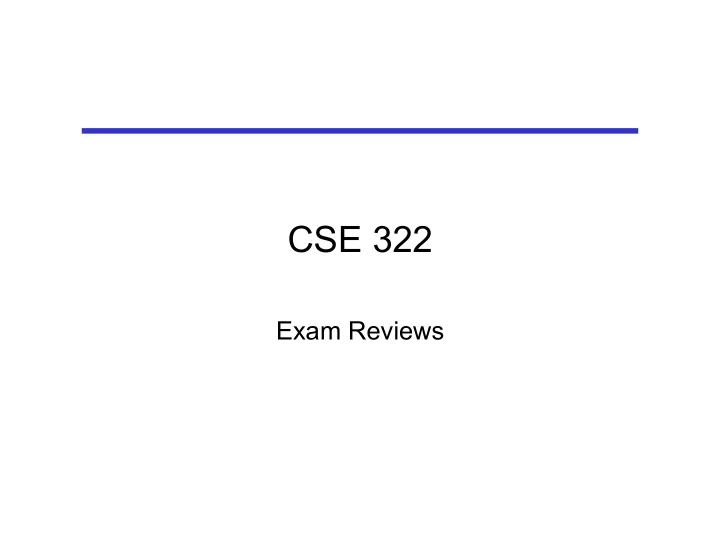

CSE 322 Exam Reviews
Basic Concepts • Formal Languages • Language/String Operations – Alphabet ( ! ) – String ( ! *) – “Regular” Operations: • Union ( $ ) – Length (|x|) • Concatenation ( • ) – Empty String ( " ) • (Kleene) Star (*) – Empty Language ( # ) – Other: • Intersection • Complement • Reversal • Shuffle • ...
Finite Defns of Infinite Languages • English, mathematical • Nondeterminism • DFAs • NFAs – States – Transitions ( % relation) – Start states • Missing out-edges – Accept states • Multiple out-edges – Transitions ( % function) • " -moves – M accepts w & ! * – N accepts w & ! * – M recognizes L ' ! * – N recognizes L ' ! * • Regular Expressions – # , " , a & ! , $ , • , * , ( ) • GNFAs
Key Results, Constructions, Methods • L is regular iff it is: • The class of regular languages is closed – Recognized by a DFA under: – Recognized by a NFA – Recognized by a GNFA – Regular ops: union, concatenation, star – Defined by a Regular Expr – Also: intersection, Proofs: complementation, GNFA ( Reg Expr (& reversal, prefix, (Kleene/Floyd/Warshall: R ik R kk * R kj ) no-prefix, … ) • NOT closed under ⊆ , ⊇ Reg Expr ( NFA (join NFAs w/ " -moves) • Also: Cross-product NFA ( DFA construction (union, …) (subset construction)
Applications • “globbing” • Compilers: – Id ::= letter ( letter|digit )* – lpr *.txt – Int ::= digit digit* • pattern-match – Float ::= searching: d d* . d* ( " | E d d* ) – (but not, e.g. expressions – grep “Ruzzo.*terrific” *.txt with nested, balanced parens, or variable names matched to declarations) • Finite state models of circuits, control systems, network protocols, API’s, etc., etc.
Non-Regular Languages • Key idea: once M is in • Cor: Pumping Lemma some state q, it doesn’t • Important examples: remember how it got L 1 = { a n b n | n >0 } there. L 2 = { w | # a (w) = # b (w) } E.g. “hybrids”: L 3 = { ww | w &! * } if xy & L(M) and L 4 = { ww R | w &! * } x, x’ both go to q, then L 5 = { balanced parens } x’y & L(M) too. • Also: closure under * , complementation E.g. “loops”: if xyz & L(M) and sometimes useful: x, xy both go to q, then – L 1 = L 2 * a*b* xy i z & L(M) for all i ) 0. • PS: don’t say “Irregular”
Context-Free Grammars • Terminals, Variables/Non-Terminals • Start Symbol S • Rules ( • Derivations + , + * • Left/right-most derivations • Derivation trees/parse trees • Ambiguity, Inherent ambiguity • A key feature: recursion/nesting/matching, e.g. S ( (S)S | "
Pushdown Automata • States, Start state, Final states, stack • Terminals ( ! ), Stack alphabet ( , ) • Configurations, Moves, |--, |--*, push/pop
Main Results • Every regular language is a CFL • Closure: union, dot, *, (Reversal; ! w/ Reg) • Non-Closure: Intersection, complementation • Equivalence of CFG & PDA – CFG ' PDA : top-down(match/expand), bottom-up (shift/reduce) – PDA ' CFG: A pq • Pumping Lemma & non-CFL’s • Deterministic PDA != Nondeterministic PDA
Important Examples • Some Context-Free Languages: – { a n b n | n > 0 } – { w | # a (w) = # b (w) } – { ww R | w & {a,b}* } – balanced parentheses – "C", Java, etc. • Some Non-Context-Free Languages: – { a n b n c n | n > 0 } Curiously, their – { w | # a (w) = # b (w) = # c (w) } complements are CFL’s – { ww | w & {a,b}* } – "C", Java, etc.
Applications • Programming languages and compilers • Parsing other complex input languages – html, sql, … • Natural language processing/ Computational linguistics – Requires handling ambiguous grammars • Computational biology (RNA)
The big picture Ability to specifiy and reason about abstract formal models of computational systems is an important life skill. Practice it.
Recommend
More recommend